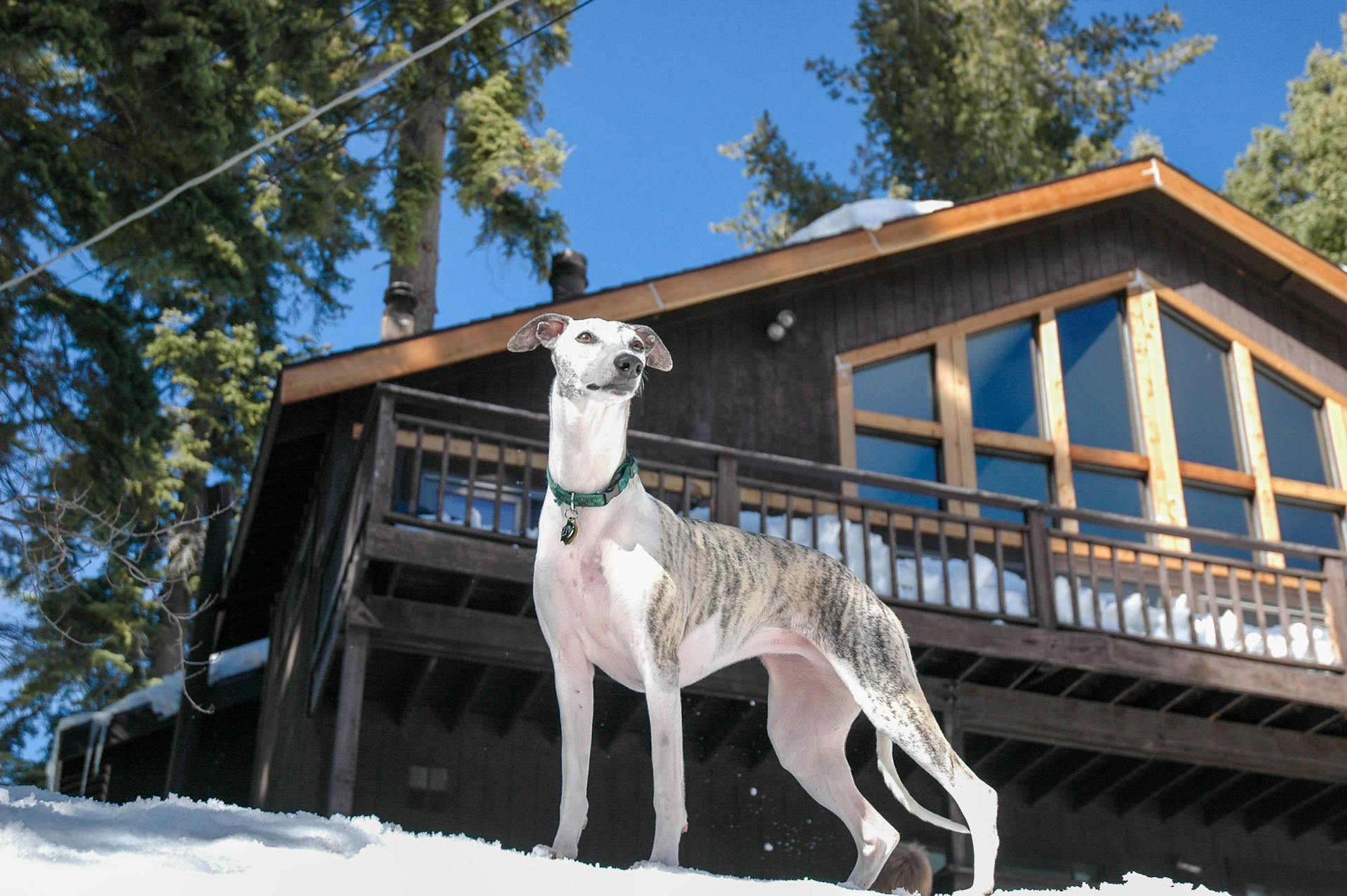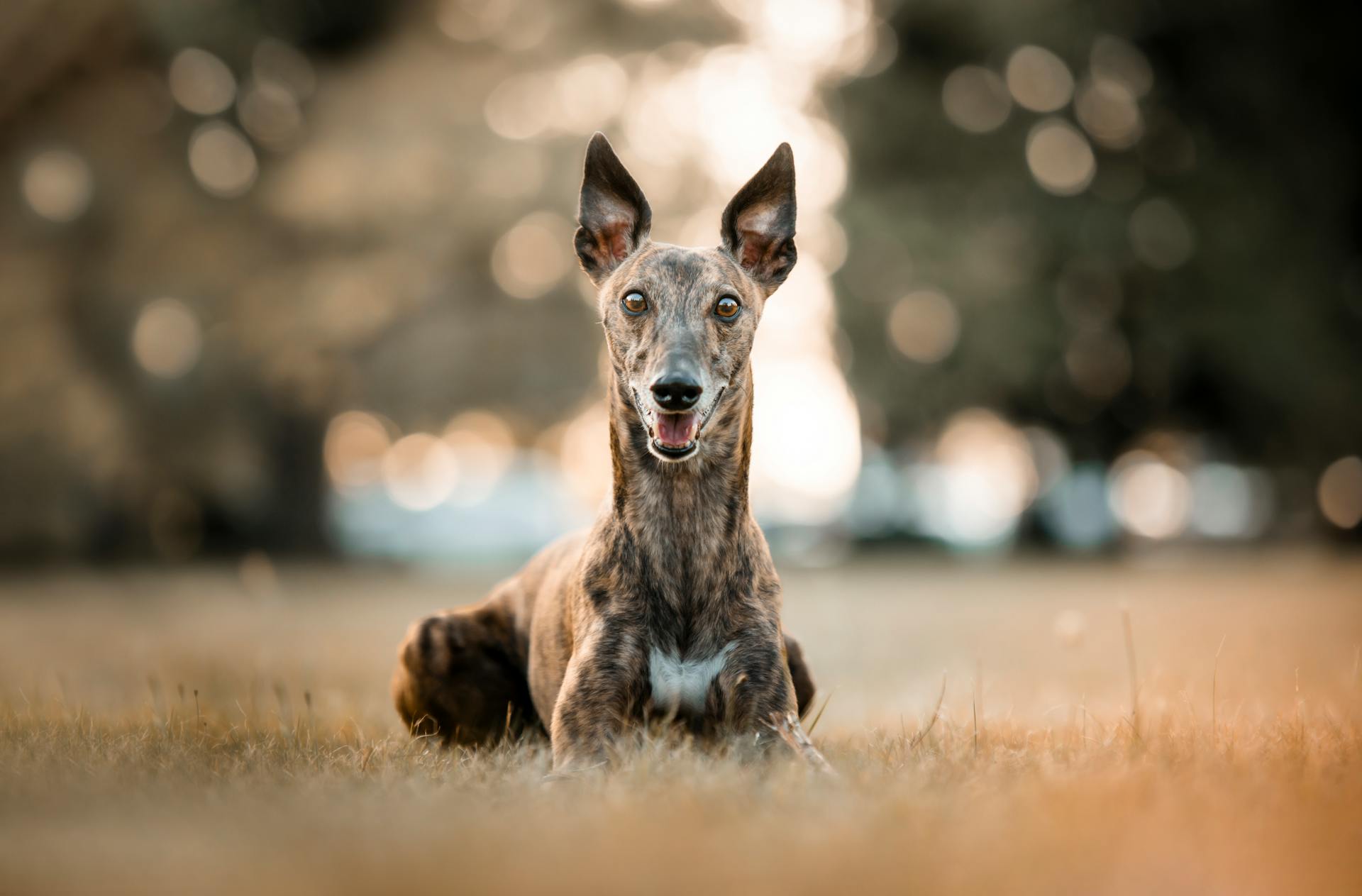
Grey Hound dogs are a popular breed known for their sleek, athletic build and short coats. They originated in England in the 16th century.
Grey Hounds are bred for speed, with the ability to reach speeds of up to 45 miles per hour. This makes them well-suited for racing, which was their original purpose.
Grey Hounds are generally friendly and outgoing, making them great family pets. However, they do require regular exercise to stay happy and healthy.
Grey Hounds are relatively low maintenance when it comes to grooming, requiring only occasional nail trimming and bathing.
Care and Maintenance
Greyhounds are laid-back dogs with a low-maintenance routine. They don't shed much and don't need a lot of brushing.
One of the best things about Greyhounds is that they don't have a strong doggy smell, so they don't need frequent baths. They can be bathed about once every two months, or more often in warmer months.
Brushing your Greyhound's teeth a few times a week can help prevent tartar and gum disease. It's a good idea to ask your vet to show you how to brush their teeth if you're not sure.
Greyhounds need their nails trimmed every two to three weeks, depending on the surfaces they walk and run on. You'll know it's time for a trim when you hear their nails clacking on your hardwood floors.
Providing your Greyhound with a coat can help them stay comfortable in cold climates, since their short hair offers little protection from the cold.
Here's an interesting read: Best Dog Food for Dogs with No Teeth
Health Recommendations
Feeding your Greyhound at least twice a day can help minimize fast eating in large quantities.
It's essential to use a slow feeding bowl at mealtime to reduce the chance of your dog experiencing GDV (bloat).
Regular exercise is crucial for your Greyhound's overall health, but be sure to avoid exercising at least an hour before or after mealtime.
Take a look at this: Galgo Espanol Temperament
A balanced diet and plenty of time with their favorite humans are key to creating a great, healthy lifestyle for your Greyhound.
Routine veterinarian checkups with blood work to screen for disease and physical examinations are excellent ways to support your Greyhound’s quality of life.
If you notice any signs of cancer, such as weakness, lameness, or swelling, be sure to consult with your veterinarian right away.
Here are some health issues to be aware of in Greyhounds:
- Gastric Dilatation-Volvulus (GDV)
- Greyhound Neuropathy
- Blood Clotting
- Cancer
- Back and Joint Problems
- Drug Sensitivity
Owner and Lifestyle
Greyhounds are a great fit for families with a moderate level of activity.
They need regular off-leash exercise to burn off their energy, which can be a challenge for busy owners.
Greyhounds are quiet and calm once their energy is depleted, making them a great choice for apartment dwellers or those who value a peaceful home.
Their independent streak means they require proper training and early socialization to be well-mannered family members.
With consistent training and socialization, Greyhounds can thrive in a variety of living situations, from apartments to homes with yards.
Their calm nature makes them a great companion for relaxing at home, whether that's reading a book or watching TV.
Take a look at this: Dog Food for High Energy Dogs
Physical Characteristics
Greyhounds are built for speed, with bodies designed for high-speed chase. They can reach speeds of up to 45 miles per hour, making them the fastest dog breed on Earth.
Greyhounds have long, lean bodies with narrow, aerodynamic skulls. Their deep inverted S-shaped chest is a prominent feature, made even more noticeable by their tightly tucked waist.
Most male Greyhounds stand between 28 and 30 inches tall and weigh between 65 and 70 pounds. Female Greyhounds are slightly smaller, at 60 to 65 pounds and around 27 to 28 inches tall.
Greyhounds have a variety of coat colors and markings, including black, red, white, blue, and many combinations. Their coats are smooth and short, requiring minimal grooming.
Here are the key physical characteristics of Greyhounds:
- Ears: Small, fine-textured, and rose-shaped
- Eyes: Dark and oval, often soulful and bright
- Nose: Long muzzle that tapers to the nose
- Coat: Short, firm, and smooth
- Coat Color: Black, white, red, blue, blue fawn, and brindle
- Tail: Long and thin with an upward curve
Polish Traits
Polish Greyhounds are speedy dogs that love to sprint and chase things, including cats, small pets, or wildlife.
Their instincts tend to take over if they catch something, which isn't good for the little critter.
Polish Greyhounds form strong bonds with their people and make excellent guardians.
Despite their large size, they're typically careful around kids of all ages.
Suggestion: Lowland Polish Sheepdog
Physical Traits
Greyhounds are built for speed, and it shows in their sleek and athletic physique. They can reach speeds of up to 45 miles per hour, making them the fastest dog breed on Earth.
Their long, lean bodies are designed for high-speed chase, with narrow, aerodynamic skulls and a deep inverted S-shaped chest that helps them cut through the air.
Most male Greyhounds stand between 28 and 30 inches tall and weigh between 65 and 70 pounds, while females are slightly smaller.
Greyhounds have short, smooth coats that require minimal grooming, and they come in a variety of colors, including black, red, white, blue, and many other combinations.
Here's a breakdown of the average height and weight of Greyhounds:
Their coats can have a black mask, ticked, partial-color, or solid markings, and their feathered tails are long and curve at the tip, forming a sickle shape or complete circle.
Training and Exercise
Greyhounds are intelligent dogs that respond well to positive and reward-based training. Consistency and short training sessions, about five to ten minutes at a time, are key to keeping them engaged.
Curious to learn more? Check out: All about Dogs Dog Training
They have a tendency to be independent and may get bored with long, repetitive sessions, so it's essential to mix things up and keep them interested. A proper-fitting collar and leash are a must when training outdoors.
Greyhounds need plenty of exercise to satisfy their natural urge to run and play. Two 20-minute runs a day or at least 30 minutes twice a day will keep them healthy and engaged. They also enjoy dog sports like lure coursing and agility, which provide great mental and physical stimulation.
Behavioral Traits
Greyhounds are loyal and gentle companions, but they can be stubborn at times.
They have an independent streak and may not always follow commands, especially if they're distracted by something interesting, like small animals.
Greyhounds learn quickly, but they can get bored easily, so it's essential to keep training sessions engaging.
Reward-based training is a great way to keep your Greyhound motivated and interested during training sessions, as recommended by the Veterinary Centers of America.
With patience and consistency, you can help your Greyhound become a well-behaved and loyal companion.
Take a look at this: Hungarian Greyhound
Exercise

Greyhounds need a good sprint, not miles of walking, to stay happy and healthy. Two 20-minute runs a day will usually suffice.
They're known as the 40mph couch potatoes, but don't let that fool you - they still need regular exercise to keep their minds and bodies active. If you don't live in a home with a large fenced-in yard, make sure you have a roomy fenced-in dog park your pup can frequent a few times a week.
Carve out time every day for walks and give your Greyhound opportunities to sprint off-leash in a safe, fenced environment. At least 30 minutes or more twice a day should keep them healthy, engaged and address their exercise needs.
These hunting dogs have a high prey drive and can be easily distracted by a passing squirrel or stray cat if allowed off-leash in an unsafe and unfenced area. A warm coat may be needed in cold weather.
Don't forget to exercise their brains, too - break out the dog toys and play with them or give them a puzzle toy.
Training

Greyhounds are intelligent dogs that can learn quickly, but they can also get bored easily, so training sessions should be short, about five to ten minutes at a time.
To train a Greyhound, consistency and positive reinforcement are essential tools. This means using praise, high-value treats, and toys to reward the dog for a job well done.
Greyhounds have an independent nature, so they may not always follow a child's whims. This can make training a challenge, but with patience and consistency, they can learn to sit, stay, and even walk on a lead.
Remember to use a proper-fitting collar and leash when training your Greyhound outdoors, especially in areas where they can run away. You'll know the collar fits well when you can slide two fingers snugly between the collar and their neck.
Socialization is also important, especially when Greyhounds are young. A group puppy obedience class is a great place to learn basic commands and make new friends.
Greyhounds are loyal and gentle companions, but they can be stubborn at times. They may not come when called, especially if there's something interesting in the area, so always keep them leashed.
Check this out: What to Feed Dogs When Out of Dog Food
Frequently Asked Questions
Is greyhound a good family dog?
Greyhounds are generally great family pets, being affectionate with their family and often good with children and other dogs. They make a wonderful addition to many families, but it's always a good idea to research their needs and personality to ensure they're a good fit for yours.
Is greyhound the fastest dog?
Yes, the Greyhound is the fastest dog, reaching speeds of up to 45 mph.
Featured Images: pexels.com


